Dixie Rainbow Chickens: Dual-purpose, backyard breed
I raised Dixie Rainbow Chickens for almost 5 years and my experience was great! Here’s the rundown on everything you need to know about this hybrid, rainbow breed chicken, including Dixie Rainbow Chicken pictures.
Pin it for later or to show you chicken lovin’ friends!
Table of contents
The beginner’s guide to dixie rainbow chickens.
I originally learned of the Dixie Rainbow chicken breed by reading on the Backyardchickens.com website about hybrid breed chickens. I knew I wanted a laying flock and a flock for meat production, so why not maintain small backyard flock of 6-7 hens that could do both?
If Dixie Rainbows were as great of a hybrid (dual-purpose bird) as I’d read, they would be the best meat chicken for my little homestead at the time. And if they were great layers, as I’d read, then eventually I could just raise that breed.
Well, that’s exactly what ended up happening! The best part of choosing a hybrid breed chicken is it allows you to have the best of both worlds, without having too many chickens running around.
What do Dixie Rainbow Chickens look like? (Identification)
One awesome characteristic of rainbow dixie chickens is they often look totally different from each other! In fact, they’re classified as a “rainbow” because there’s no set look to them – each chicken has the most unique feather pattern. Their varied feather patterns and color patterns provide some of the most vibrant plumage and tail feathers. I experienced birds with both earthy colors and others with vibrant colors. They were the most unique chickens I raised, and are currently still my top choice (right next to Barred Rocks!).
The standard pattern of a Dixie Rainbow is tan/brown and speckles, somewhat like this picture below.
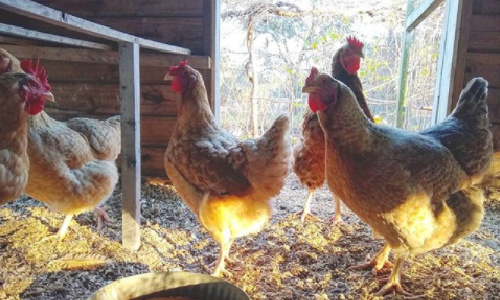
But the beautiful characteristic of Dixie Rainbows is that every now and then you get a wild card. From our last flock, we got 2 brown hens, 2 more standard looking hens, 1 beautiful speckled roo and the head-honcho and first-hatched the snow-white roo!
Some chicks may also have winged eyeliner or a small flick of black stretching from the corner of their eyes.
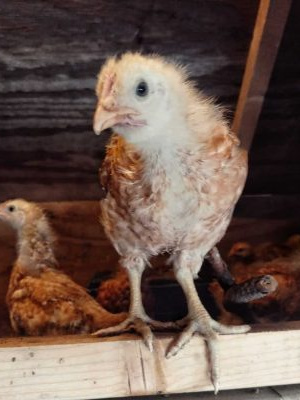
Behavior
These hybrid breed chickens are full of great personalities. Full of life, they’ll strut around the yard like they’re the best breed there is (they’re pretty close to it!).
You’ll find the hens are wonderful mothers when they go broody, committing to the brood and hatching their young to success. Watch out, though! A broody hen might give you a good peck if she’s a committed mama, which is almost always. Mainly, though, you’ll experience a sweet bird.
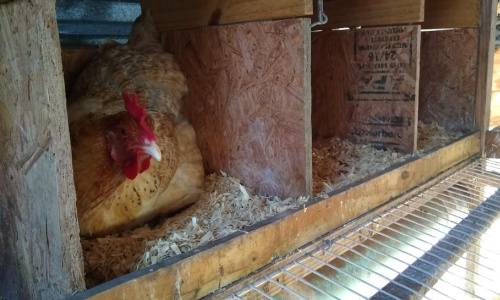
In fact, even when you incubate eggs they prove their resilience. The few eggs that had trouble pipping or zipping have been fighters! It’s amazing to watch a little day-old chick decide that today is a day to live, not die. We, of course, assist when appropriate!
I mean, just look at this strong little chick!
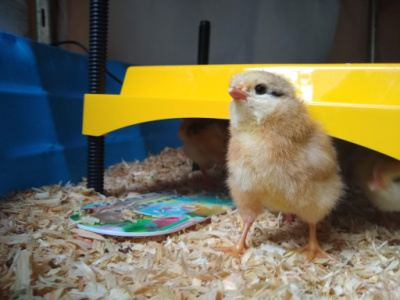
As for the roosters, in my experience, I haven’t had an aggressive Dixie Rainbow rooster yet. Large? Yep. You betcha. A little bit slow to learn? Yes, I’ll have to admit.
But they’re good roosters and you don’t have to worry about being attacked. They’ll watch over the hens and they’re beautiful. I haven’t had a bad looking Rainbow Roo’ yet!
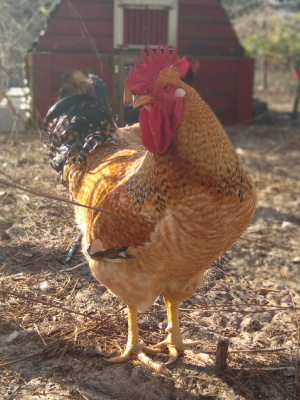
Growth
Since Dixie Rainbows are a dual-purpose breed, they grow quicker than the average. If you’re raising rainbows as meat birds, you can expect them to reach market weight around 12-13 weeks and will be 6-8 pounds of weight at maturity. BIG BIRD. This is the perfect weight for a broiler, or fryer.
At 12-13 weeks your flock will have full combs and wattles and your roosters will start to cock-a-doodle-doo. This is my most recent flock, and yes, they are ALL Dixie Rainbows – full bred. The flock in the photo below are roughly 13 weeks old!
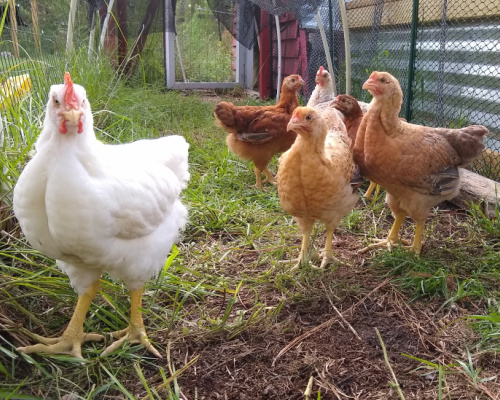
Dual purpose birds don’t typically take longer than 18 weeks to reach market weight – and by that time you’ll have actual big birds on hand. By 20-24 weeks of age or older, you’ll need to plan to utilize your chickens as roasters or stewing chickens. For more information on the difference in sizes when raising, culling and cooking chickens you can read this informative article from The Kitchn.
Although I have not raised Cornish Cross chickens, I didn’t love what I read about them. Cornish Cross chickens are probably one of the most stereotypical, generic meat chickens. It’s what you often find in factory-farmed setups, but I do know smaller homesteaders who choose to raise Cornish Crosses.
The reason I chose against it is that they’re bred to grow at a very fast growth rate, meaning at some point they’ll likely not even be able to support their own weight. Cornish Cross chickens are a good breed if you are good at sticking to a schedule, as they’ll need to be promptly culled once they’ve become a mature chicken. At their mature weight, Cornish Cross chickens can grow to 8 lbs in as little as 8 weeks.
I’ve also read not to raise them in the summer season as they are not heat-tolerant birds.
Egg Production
Egg production might be one of the most important characteristics to look at in a chicken for most people. It is absolutely possible to find a breed of chicken that produces both quality meat and provides a plethora of large eggs throughout the year. Enter: dual purpose, or “hybrid”, chicken breeds *cough…the dixies!*
What color eggs do Dixie Rainbow chickens lay?
The rainbow layer chicken lays a medium-large brown egg, so if you’re looking for different egg colors then Dixies aren’t for you. These yummy brown eggs are often more towards the larger size and I’ve even gotten a few double yolks!
If you’d prefer a flock that lays a variety of eggs, you’ll need a variety of birds. Luckily, Dixie Rainbow chickens get along well with other breeds. Try pairing them with Buff Orpingtons, who are some of the best egg producers. For colored eggs, choose an Easter Egger breed that lays blue eggs! Easter eggers are a blue egg layer breed and, while they lay beautiful eggs, they’re not the best choice for a meat chicken as they stay pretty small.
I’ve raised Rhode Island Red chickens who are also great layers that lay light chocolate brown fresh eggs. Different breeds bring in a slightly different egg color ranging from the standard white egg, blue eggs to dark brown eggs to the Olive Egger, giving you olive green eggs!
The options are endless, really. No matter if your chickens lay lots of eggs that are colored or not, they’re all the same on the inside regardless of the shell color. Yummy, fresh eggs with rich yellow-orange yolks!
Are rainbow chickens good layers?
On average, Dixie hens are great egg producers, laying around 225-250 eggs a year. Keep in mind, to receive optimal egg production you should always supply your hens with a feed of at least 16-17% protein along with unlimited access to clean water. Your local feed store, Tractor Supply or Rural King should have this. Dixies are a large size, fast growing bird.
If you supply them with proper care, a balanced diet with adequate protein and clean drinking water, they’ll supply you with beautiful, farm-fresh eggs.
At what age do rainbow chickens start laying eggs?
You can expect these hybrid hens to start laying at the end of the spectrum of 20-24 weeks.
Jersey Giant hens are efficient egg producers and hearty meat chickens. Among the largest breeds, Jersey Giants are a great dual-purpose chicken option for your homestead if you have the space. Barred Rocks and White Rocks are also an acceptable dual-purpose breed of chicken, better suited for a smaller homestead than Jersey Giants.
Are rainbow chickens cold hardy?
I’ve never had a problem in the winter with my hens not laying. In fact, optimal egg production for my Dixies were always in the cooler months. I will say, though, that the summer of 2020 was particularly hot and their laying significantly slowed down.
From my small flock of 7 hens, I usually received 4-5 eggs a week. In the heat of the 2020 summer with constant heat advisories, I was lucky to get 4 eggs a week. This wasn’t the norm, though.
I live in Eastern Kentucky now and look forward to raising Dixie Rainbows in this cooler climate, eventually. I anticipate they’ll do well as they’re large, hardy birds – similar in shape to Barred Rocks or a Buff Orpington.
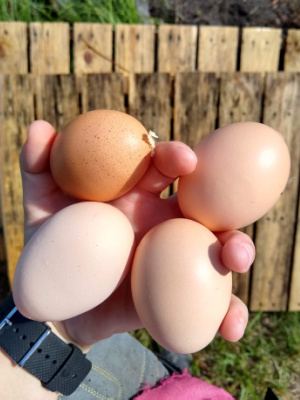
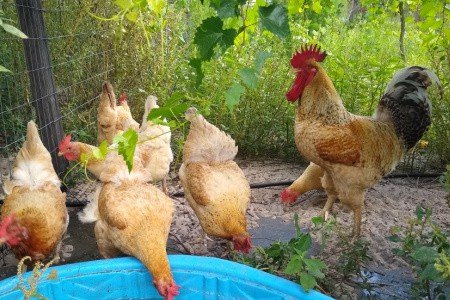
Climate
For folks who live in more southern states, you don’t have to expect a bad molt from Dixie Rainbows. Here’s a picture of my flock in the winter of 2019. Our winters in Florida are quite mild and I’ve never experienced a real molt. This year my Dixies molted more than they ever have.
I live in West Central Florida. That means my chickens must be able to endure some intense heat and humidity. My Dixie Rainbow Chickens have done wonderfully in the heat of the summer. Their egg production dropped off slightly, but that’s expected.
In the winter of 2021, the temperatures dipped down pretty low here. Although it never got cold enough, for long enough, for me to worry about keeping my chickens warm in winter weather. The Dixies still did great in the low 30’s. These chickens are great adjusters!
Where are Dixie Rainbow Chickens for sale?
In 2018 I bought my first flock from The Chick Hatchery, but it looks like they no longer provide Dixie Rainbows at their hatchery. Here’s my receipt from my purchase in 2018, although expect prices to have changed given the current economic climate.
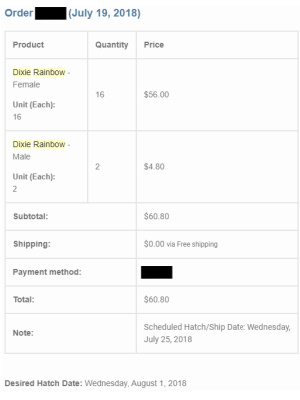
Search your local poultry farms and if they don’t have what you’re looking for, browse the online options and pick up your chicks at your post office. If ordering chicks through the mail seems wild, know that chicken lovers and poultry enthusiasts all over the world order chicks online – trust me, I was skeptical at first, too!
Updated Friday, November 17, 2023: Hoover’s Hatchery seems to still provide Dixie Rainbow Chickens.
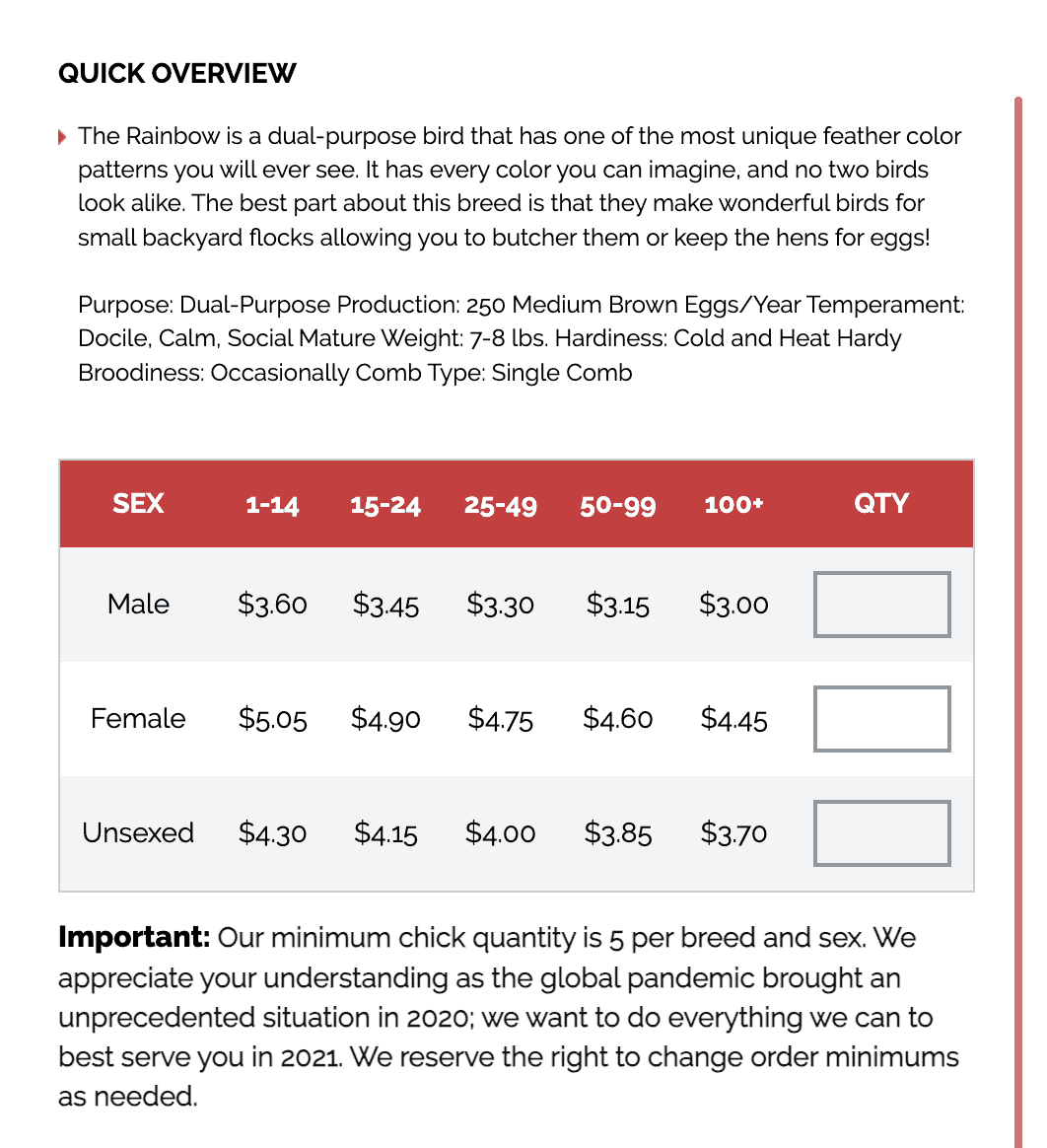
Updated Friday, November 17, 2023: Abendroth Hatchery, who I’ve never ordered livestock through, seems to also provide Dixie Rainbow Chickens.
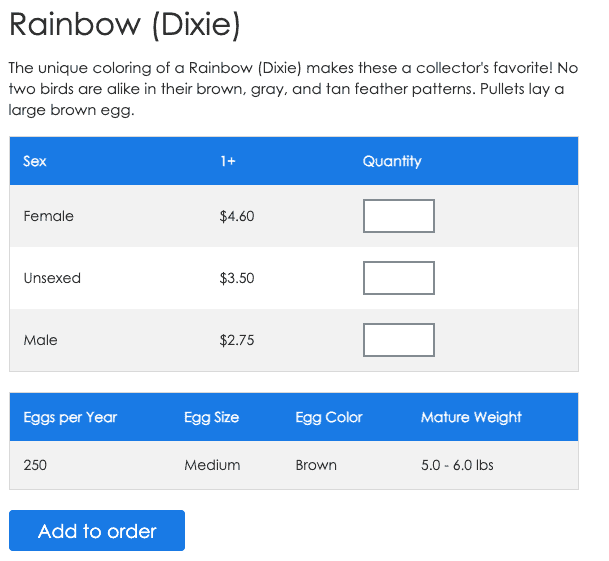
Be sure when you receive your chicks that your brooder is properly set up! If this is your first time raising chicks, I promise it isn’t that hard.
Here are a few resources to get you started:
- How to raise chicks for beginners
- Brooder heating plate vs. heating lamp
- How to raise meat chickens for beginners
Dixie Rainbow Chickens: Summary
Although there isn’t a lot of information on the web about this dual-purpose, hybrid breed chicken I can tell you they’ve been a joy to raise from a little chick to old chicks. You’ll get large birds with even larger, delightful personalities.
I raised only purebred Dixie Rainbows for a while, maintaining a small layer flock of 5-10 birds at a time and incubating eggs to raise meat birds as needed. They were an excellent choice for what I want in small backyard flocks.
I have plans to maintain laying flocks of Australorps and Orpingtons eventually because they’re some of my favorite chicken breeds. They’re also both popular choices among hybrid lovers, producing a large bird and quality meat. They’re also wonderful birds to watch because their color palette varies (check out these Lavender Orpingtons!). So if you’re looking for a fun, colorful journey out of your chicken raising days, these are all great options!
But, there you have it. Everything you need to know about Dixie Rainbow Chickens! There are so many chicken options – White Rock chickens are another dual purpose breed that’ll finished early, while Freedom Rangers are a slower growing breed.
Depending on your personal situation, the amount of space you have and what your end goal is, I promise there is the perfect breed for you. It just takes a little reading, and maybe trial and error. That’s what this lifestyle is all about.
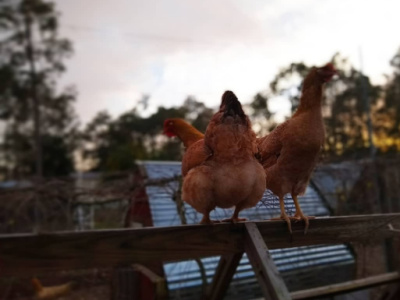
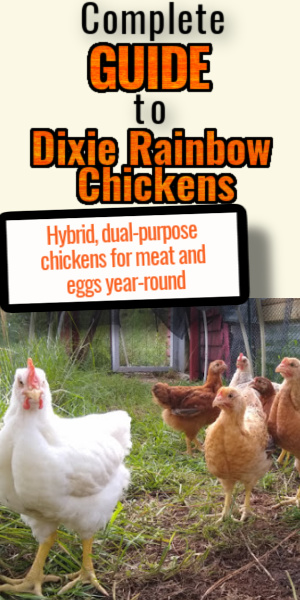

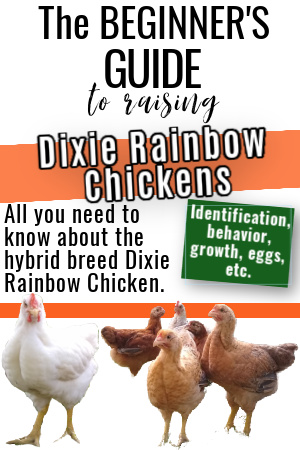
I bought some Dixie rainbows from TC this year 2 females and a male they are so beautiful and friendly I’ve only had one incident where my roo tried to attack me and it was kinda my fault and it was just a scratch lol. but he’s a big scary cat lol whenever I try to touch him he runs away complaining 🤣❤️ I definitely would like to add more Dixie hens to my flock someday.
How can I tell which are females and which are males? I have 6 that were sold as all females but I am questioning one or two of them.
Hi Diana! Telling a chicken’s sex is no easy feat! When they’re young, a trained eye can often tell by the wing feathers. As they grow, the best signs will be their tail feathers and their head pieces, or lack thereof. I always waited until my chicks were a bit older to determine who was a roo and who wasn’t.
Hi Chelsea, I am located in North Central Florida. I was wondering if you sold hatching eggs or chicks. I am looking to adding some Rainbow Dixie chicks to our flock, but I can’t find a source.
Hi Jackie! First, congrats are raising chickens! I have moved away from the area but always had luck with the hatcheries. It looks like Hoover’s might have some available! https://hoovershatchery.com/rainbow.html
Best of luck to you and let me know if I can try and help with anything else!
Hello! I know this post was over a year ago, but it thought I might try my luck. I have a white chick (with a few random patches of color) that I suspect is a Dixie Rainbow, but she has gray skin (feet, vent, face, tiny 7-week old chick comb, everywhere). She is from Rural King. My question is, can Dixie rainbows have gray skin? Thanks! I hope you see this 🙂
Hi Kylie! My Dixie Rainbows never had grey skin, although that doesn’t mean yours aren’t any % dixie. You might call Rural King and see if they can help you identify what your gal might be!
A hybrid as I understand it is a cross between two specific established breeds. What are the two breeds that make a Dixie Rainbow? Also, as I understand it, you do not breed the hybrids to each other to make more of that hybrid. You go back to the original 2 breeds. If you breed the hybrids with each other and do it in a systematic way and get them breeding true to type you’ve basically created a new breed. A hybrid is not a true breed or a pure breed.
Hi Kathy here, I brought rainbow chickens at tractor supply, I got four one was solid white, one was cream and white, the other is motley color, the male was specked color but they all had punk rock feathers in their head. I am beginning to wonder if they are rainbow chickens. They don’t look like your pictures. They are now about 16 wks old.
Hi Kathy! Dixie Rainbows are usually a modge-podge of varieties. The best thing to do is to call Tractor Supply and see what they actually sold you if you are second-guessing. I’m sorry I couldn’t be more help!
How can I tell if I have a rooster or hen?? I have 3 DRs and I just can’t tell they are around 4 months old and are HUGE already!
Thank you for your insight on this breed. I recently got myself some chicks and I was curious to know what the life expectancy is on this breed. I am also from Florida and I hope that they do okay in the summer heat.
I loved this article and I’m considering Choosing these to be my egg laying flock, But I do have one question. How easy are they to tell apart from each other? I never use mine for meat so I tend to like to be able to tell them apart.
Thank you for the article!
Hi Gabriel! I have honestly never been able to tell my chickens apart unless they had distinctive markings. Dixie Rainbows are often very different from one another, but I also had a few over the years that looked identical. It all depends on how “close” you are with your flock.
Hi Chelsea I just bought 4 rainbows at my local Tractor Supply. It was a straight run and I think I have 2 male and 2 female. So I have a few questions. How many males can I keep together? I have 3 ducks 1male 2 female khaki
campbells and a wyandotte hen. They get along well, my drake gets a little pushy but not bad. Do you think I will have any problems housing them all together? Thank you. Jennifer
Hi Jennifer! In my opinion, this all depends on the animals individually. When I tried keeping ducks and chickens together it didn’t work out because the ducks got things too wet and chickens can’t live in a moist environment. On the other hand, if you have enough room you might be able to make it work. Some males get along, others don’t. If you try housing them together, keep a close eye on their dynamic and be sure to have a backup.
We got some from Hoover’s hatchery first week of February. They’re not out anymore
I’m a beginner and have read about getting chickens vaccinated, is this something that you do to your chickens. And is it safe for egg consumption. At what age and I guess possibly they could be vaccinated before purchasing. I’ll be purchasing through local farm store.
Great article, thank you
Dana
Hi Dana! Sorry for the delay in response. I’ve personally never vaccinated my flock but other people I know have. Since I’m not a registered vet and do not have veterinarian training, my best advice would be to call a local vet or try a few forums or Facebook groups where there are registered vets looking to help out for free.
Chelsea, I really liked this article! Lots of us are looking for a dual purpose bird right now. I am going to look into finding these near me! Thanks for sharing.
Blessings Dash
Anytime, Dash! If you look at Hoover’s Hatchery they recently had them and also Tractor Supply!